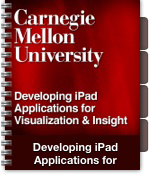Press Release: Carnegie Mellon Students Learn iPad Programming in New Course Co-Taught by Professor and Pros
Lectures and Course Materials Available Free on iTunes U
Contact: Byron Spice / 412-268-9068 / bspice@cs.cmu.edu
 PITTSBURGH—Students at Carnegie Mellon University this semester have been learning the fundamentals of programming for the iPad in a course taught for the first time by university faculty and a group of top industry developers. The lectures also are available for free through iTunes U.
PITTSBURGH—Students at Carnegie Mellon University this semester have been learning the fundamentals of programming for the iPad in a course taught for the first time by university faculty and a group of top industry developers. The lectures also are available for free through iTunes U.
Niki Kittur, assistant professor in the Human-Computer Interaction Institute, said the course, "Developing iPad Applications for Visualization and Insight," helps students understand that how people use iPads affects how and what is programmed.
"This is a computer you use while sitting on your couch," Kittur said of the challenges and opportunities facing an iPad programmer. "You want things to work differently than if you were sitting at a desk. You can carry it around. You interact with a multitouch screen; you drag things around the screen or flip through things. Kids who are two years old use it. It's a very different paradigm."
The course has proved popular with students from across Carnegie Mellon — about 90 students showed up for the first day of class, though the course had enrolled its limit of 30. Anyone, however, can access the lectures for free as HD videos at Carnegie Mellon University on iTunes U. They are available to download with one click via iTunes U on your desktop or the new iTunes U app on iPad, iPhone and iPod touch.
The course covers the essentials of creating an app, as well as the latest features of the iOS 5, the world's most advanced mobile operating system. But it also will increase students' understanding of the cognitive processes involved in transforming visual representations into mental representations, insight and discovery.
"We're not only teaching students how to program," Kittur explained, "but what they should be programming. We want to think of new, user-centered ways for people to consume information and then implement those on an iPad."
Using fingers to interact and manipulate maps and 3D visualizations on the iPad display clearly can be a powerful experience, said Kittur, who admits to having downloaded more than 300 apps onto his own iPad. "I'm one of those persons who has 10 pages of apps," he said.
But programmers also must be aware of the limitations to that interaction. Users lose the feedback they receive from pressing a key on a physical keyboard, as well as some precision in manipulating images. "Your fingers cover up some of whatever you're manipulating," Kittur noted.
Online viewers of the CMU course will see the same lectures as the students, but cannot receive academic credit for the course.
The Human-Computer Interaction Institute is part of Carnegie Mellon's top-ranked School of Computer Science. Follow the school on Twitter @SCSatCMU.
###